#Ruler!Christopher Reed
Explore tagged Tumblr posts
Text
Ruler!Andre: How does it feel to be weaker than your creations.
AB!Jinchul: How does it feel to know you have become the tyrant I once was?
Ruler!Christopher: *Plays 'Emotional damage'*
Ruler!Go: Ah I see my disaster children are finally getting along.
DM!Cha: Sir, your 'children' are a Shadow Monarch and an Absolute Being. You should be just as scared as the rest of us.
*Screaming*
BM!Yoonho: I see Jinwoo got his memory back.
FM!Lennart: So it seems.
*Screaming stops and AB!Jinchul walks out of a room*
AB!Jinchul: *Smiling* He hasn't yet, but I have.
*MoB!Goto: You're about to make a stupid decision!
**MoA!Laura: every decision he makes is stupid.
Ruler!Zhigang: I'm not about to just make a stupid decision, I'm about to make an extremely stupid decision!
*-Monarch of Beginnings
**- Messenger of Angeles
#solo leveling#S-Rankers#incorrect quotes#Absolute Being#woo jinchul#Ruler!Thomas Andres#Ruler!Christopher Reed#Ruler!Liu Zhigang#Messenger!Laura#Ruler!Go Gun-hee#Monarch!Hae-In#Monarch!Goto#Monarch!Yoonho#Monarch!Lennart
47 notes
·
View notes
Text
Monarch/Ruler Successors AU
This is just my personal headcanons on this AU since I have my own take
Kind of a mashup of others' ideas honestly, plus a couple of my own though I think they came from one person in particular
Very subject to change as I read Ragnarok. And when I'm finally able to play the game
Monarchs:
Choi Jong-In as The Monarch of Destruction, the King of Dragons


Baek Yoon-Ho as The Monarch of Fangs, the King of Beasts


Hwang Dong-Soo as The Monarch of the Iron Body, the King of Monstrous Humanoids

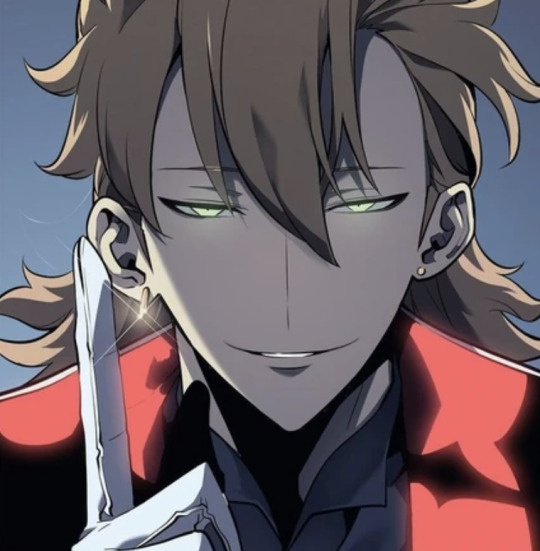
Kang Tae-Shik as The Monarch of Transfiguration, the King of Demonic Spectres

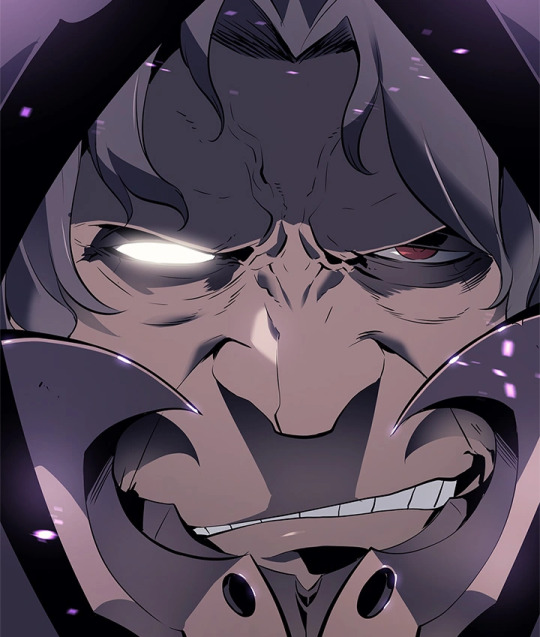
Eun-Seok as The Monarch of Frost, the King of the Snow Folk

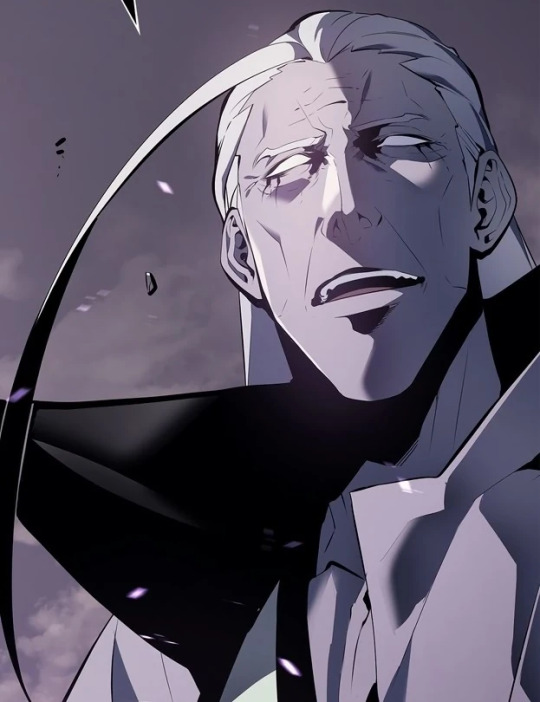
Lim Tae-Gyu as The Monarch of the Beginning, the King of Giants

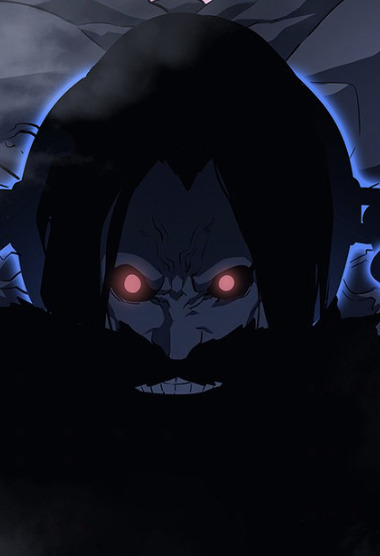
Goto Ryuji as The Monarch of White Flames, the King of Demons

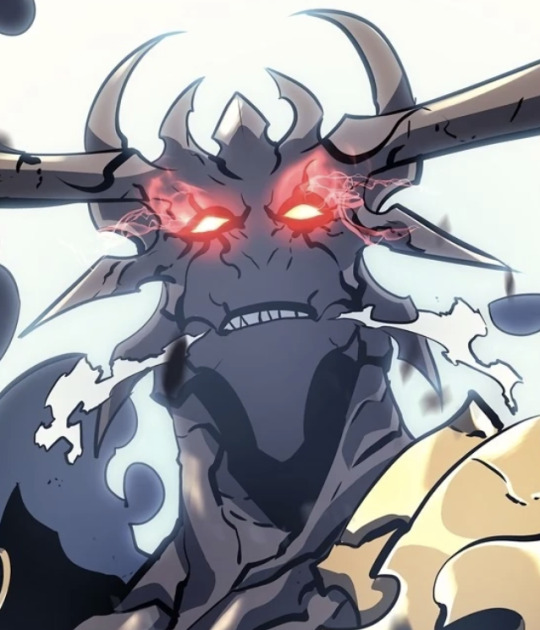
Park Hee-Jin as The Monarch of Plagues, the Queen of Insects

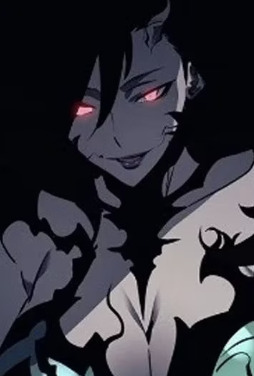
Ruler Vessels:
Cha Hae-In
Min Byung-Gyu
Thomas Andre
Liu Zhigang
Christopher Reed > Lennart Niermann
Sung Il-Hwan
Go Gunhee > Woo Jin-Chul
Siddharth Bachchan (Don't have a pic for him, but that's not my fault)

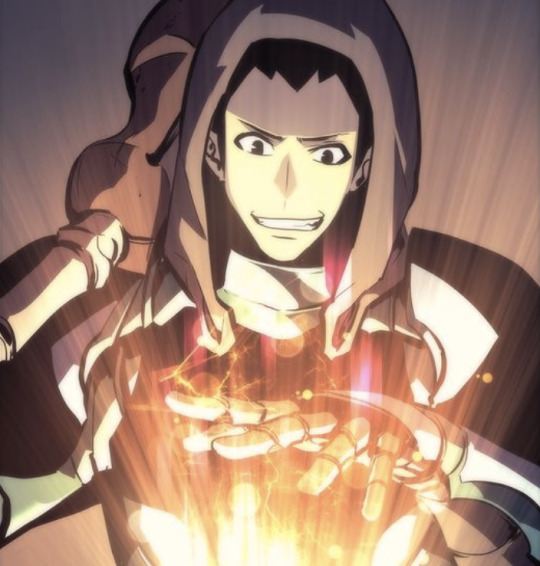


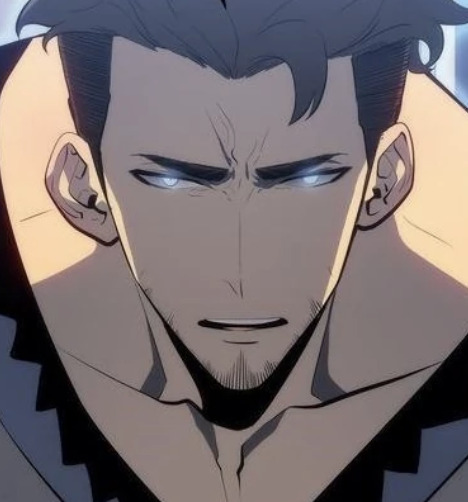
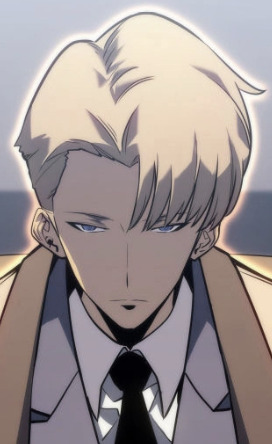


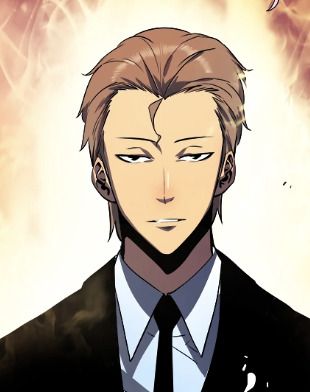
Open to questions. Because I don't know what else to say
#solo leveling#choi jong in#baek yoon ho#hwang dongsoo#kang tae shik#sl eunseok#lim tae gyu#goto ryuji#park heejin#cha hae in#min byung gyu#thomas andre#liu zhigang#siddharth bachchan#lennart niermann#sung il hwan#woo jin chul#solo leveling aus
87 notes
·
View notes
Text
messy Christopher Reed head-canons
real upset that he didn't get that much screentime, especially when he looks this pretty...

he collects tea cups
he's one of the few with a brain cell but thinks its funnier to sit back and watch the ones without brain cells do literally anything
Thomas commonly tries to embarrass the shit out of him and it works every time. mans gets secondhand embarrassment easily
he can wear heels
hates the combination of chocolate and oranges
he and Min Byung-Gyu can talk about tea for hours. and they have
he's really good at fixing house appliances and etc as he hates human interaction and would simply rather do things himself, so he's got a lot of weird house and car knowledge
he hikes a lot, and camps a lot too. really likes the outdoors
he once chained himself to a bike rack near sea world when protesting and Thomas got his hands on the photo and never let him live it down
he would go to protests still but. human interaction
was studying to be a marine biologist when life got in the way. still really likes marine life a lot. take him to the beach and he’ll go wild. show him a tide pool and he's frothing at the mouth
ironically he loves sushi and sashimi
he's got a really big and cool looking aquarium. several, actually. got a whole room dedicated to em. almost got an octopus but for now he's got a lot of fish, seahorses, an eel, shrimp, and a lobster.
also got a koi fish and goldfish pond outside

#christopher reed#christopher reed solo leveling#solo leveling#only i level up#character: christopher reed#fandom: solo leveling#mentions of other characters#min byung-gyu#thomas andre#head canons#start rambling/#agh. pretty man christopher reed#real talk? im so sad we didnt get to see more of him#literally all we got was him going 'ill take a ruler down with me' and like. thats it???#not to mention his transformation was super cool too#theres gotta be an AU out there where sung jin woo protects chris anyway. right? or am i gonna have to make it myself...#might just do that. or one where thomas comes to help him or something. i dunno. i just :( chris my beloved pretty boy...#him AND lennart. ive still got hope for lennart gettin a lil more screentime#anyway thats enough of that. now ive got a saved! chris au... or perhaps... shadow soldier! chris?#/end rambling#HOLD ON WAIT#IS HE WEARING CROCS IN THAT LAST PIC?#OH MY GOD KING BEHAVIOR
28 notes
·
View notes
Text
In the epilogue timeline, Sung Il-Hwan remembers the prev timeline. The rulers and monarchs are the ones who remember, so that implies that when the rulers were trying to patch up his soul as best they could with their own mana, Il-Hwan basically ended up a ruler, enough of one to be immune to the Chalice overwriting that local area’s history even though he did fall apart/die.
Obvs the rulers didn’t know that was a thing or else they could have made some humans able to remember re the invasion and shit, which would have definitely been something worth trying for purposes of ‘how to help this species not all get eaten/collateral damage’d??’
Presumably the rulers knew that repairing a falling-apart soul was possible bc of Ashborn’s shadows but didn’t just do it Ashborn’s way bc the dead souls he messed with ended up brainwashed to love him? Enough to kill their own families/species (see the implied zombie apocalypses of Earth) and that is Moral Event Horizon shit so they weren’t going to do it to some guy who was dying bc he Did His Best to protect people??
The rulers are referred to as ‘fragments,’ and anyway there’s potential both in divergence AUs and less stupid ending fics to them seeing Il-Hwan as One Of The Family, since like. That’s their mana?? He’s desperate to protect his kids?? Yep, same.
1. Il-Hwan isn’t able to protect Jin-Woo’s soul/shadow long enough for him to come back to life: as a basically-ruler and basically-monarch they find themselves with their memories 10 years ago. Jiin-Woo didn’t get Ashborn’s explanation and finds out from Il-Hwan re zombie apocalypsing. Meanwhile Ashborn and his army are in deep trouble since the other monarchs know he turned against them and they’re massively outnumbered, so Il-Hwan and Jin-Woo going to kill him might be for the best...
2. Il-Hwan is a little more stable and goes to save Christopher Reed from the monarchs. Reed retired due to Kamish PTSD and this guy has the same mana as the people who kept him alive during that AND Il-Hwan saved him before starting to slowly fall apart and them sharing ruler mana means he feels like family, so he’s threatening to immolate people who want to take him away. Adam White informs Jin-Woo monster-dad is at Reed’s so he rushes over.
3. Post-non-stupid-ending ‘verse, the rulers are all sibs, Igris’ people all come from a tree and are sibs, rulers adopting Igris’ people explains why some died alongside Ashborn, souls are basically turned into shadows by the power of Adoption Papers... Jin-Woo’s experiences with basically every non-monster inhabitant of an alien planet seeing him as Best Little Brother/Nephew who did so well ;_; a good boy cinnamon roll who protected all the families~
#solo leveling#humans are like that is a terrifying inhuman eldritch necromancer#Jin-Woo having to keep more people from throwing down#when he's insulted#to other hunters he was a laughingstock burden#then his shadows Do Their Best for him#and Jin-Ho#but he's still the older brother there
50 notes
·
View notes
Text
MCU Phases 4 and 5 Wishlist
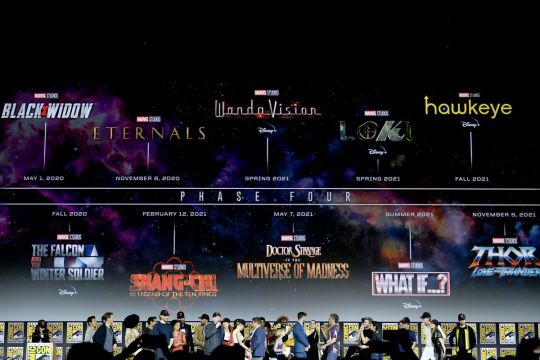
Last night at San Diego Comic Con, Marvel dropped their pants and coated the audience in a thick, rich layer of big-and-small screen announcements. Briefly recapped: across Phases 4 or 5 (not that that means anything), we’re getting Black Widow, The Eternals, Shang Chi and the Legend of the Ten Rings, Doctor Strange and the Multiverse of Madness, Guardians of the Galaxy Vol. 3, Thor: Love and Thunder, Black Panther 2, Captain Marvel 2, the Fantastic Four and Blade. On the streaming front, the previously announced series were all confirmed, and in a move most probably didn’t see coming, Marvel added a series based on their often bizarre What if? Series, which speculates on what might have happened had some element of continuity gone a different way (and which has become a bit moot in the comics in an era where continuity is gleefully mixed and nixed whenever an editor wants a sales boost).
As folks might be aware, I’m not a huge fan of Disney, skipping almost all their movies, but I have a severe weakness for the MCU. There’s a lot of wish lists going around as to what we want to happen in these movies and series, but as you know if you’ve read my blog before, the correct answers are mine. Since you can rest assured these answers are the best, I graciously share them with you now. Remember, I’m never wrong.

Mjolnir Gets Retired
I am totally down with Natalie Portman’s Jane Foster as the God of Thunder. There will be those who call to give her the same powers and weapons Thor had, but why would we want to do that? In the comics, she’s still Jane Foster while Thor is still Thor, and with Chris Hemsworth also in the film, there’s no reason to think that won’t be the case here. Instead of simply “Female Thor”, she needs her own set of traits and skills. Start with giving her a new weapon; a magical spear would be just right. Mjolnir got its greatest moment of glory in Endgame, and from a sheer story perspective, it is time to retire the venerated hammer.

Rebellion in Wakanda
I’m going to be in the minority on this, but: the Dora Milaje have gotten shafted in the MCU thus far. In the best of the comics, they are the king’s guard, but they are also a group of women with independent minds and goals who don’t always agree with the king. In fact, members have rebelled several times. In the movies to date, they exist to devote total fealty to T’Challa, never once seriously questioning anything he does. This is a terrible fate to befall an actor with Danai Gurira’s fire. Instead of existing merely to poke holes in things on behalf of a (male) ruler, it’s time these ass-kicking ladies got to play a more important, and complex, role.
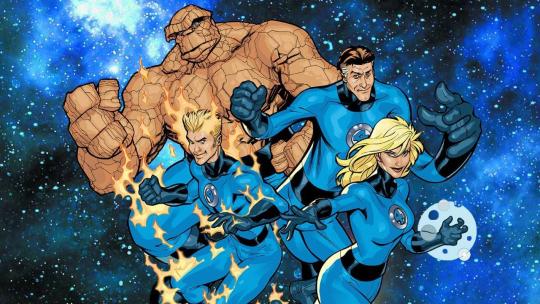
Christoph Waltz as Doom
This idea isn’t mine, but was passed on by a friend who is clearly brilliant. There’s not much to say about this one: the actor who made his reputation playing two very different roles in Quenton Tarantino films is the perfect choice for the literally tin-plated dictator. As for the rest of the cast, Keanu Reeves is the favorite for Reed, but I have another idea in mind for him...
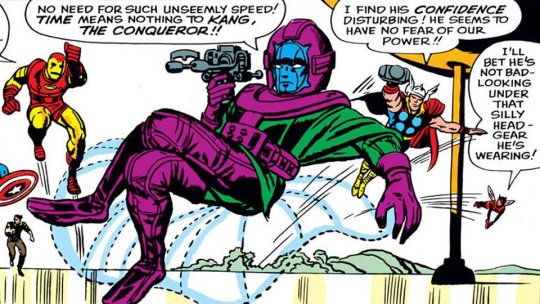
The Master of Time
That said: it’s about time to get Kang involved in this universe. When it became obvious that Endgame was going to involve time travel, I slapped together what I thought was a pretty good post-credits tease that would introduce both him and the Fantastic Four side of the universe. Obviously, nothing like that happened, and there were no Avengers movies or mass team-ups of any kind announced at SDCC. Yet with time travel established, the potential to bring in this reality-warping mega-baddie is always there.
Don’t Undo Iron Man 3
Yes, fans are shooting their shorts over the fact that the real Mandarin will be the villain of the Shang-Chi movie. But those of us who don’t rub the comics on ourselves regularly recognize the truth: Iron Man 3 had a great twist that was one of the few truly creative decisions in a modern blockbuster, and it would be a shame to overturn on the whim of a handful of hardliners. Have a “real” Mandarin, but keep Ben Kingsley’s washed-up, hedonistic actor on the books. Maybe even give him a cameo.

Unrelenting Nightmare
Director Scott Derickson has already said he wants to use Nightmare, a being who feeds off his namesake, in the Doctor Strange sequel, and given that it is apparently multiverse-focused (and that Strange has few interesting villains), this is probably a given. Marvel has been after Keanu Reeves for a long time; most people seem to want him for Reed Richards, but may I humbly suggest we go against the hype and cast him as a dimension-devouring trickster deity instead? As a side note, please, please follow up on Chiwetel Ejiofor’s Baron Mordo. He was the best part of the first film, and it’d be a shame to let him trail off into the ether.
Take Some Risks in Captain Marvel
Captain Marvel was fun. It was not the kind of movie that took risks, however, or blew anyone away, despite amazing box office numbers. CM will be an idol for little girls; it’s time to think outside the box, utilize the oddness of Marvel’s galactic properties, and make her next movie one that can rival the time-hopping chances DC has taken with Wonder Woman. Brie Larson needs more to do than pose heroically and hit things.
Where’s Spider-Man?
More of a question answered than a wish: a lot of people are freaking out because Spider-Man was not mentioned last night, despite a post-credits tease that’s impossible to ignore. Relax: the deal between Marvel and Sony likely just means Sony has to finalize plans and sign off on the next film before Marvel can announce it. Far From Home cracked 800 million at the box office, and the refurbishing of Spidey’s tarnished reputation by Marvel is one big reason Sony’s own dull, uninspired Venom series is now a viable money-maker. It would be the height of stupidity for Sony to pull out of the deal now; expect Spider-Man: Homeboy or whatever it is called to be announced for 2021 before much time passes.
Make What If? Truly Bizarre
As a series, What If? wasn’t always great, but it was always interesting. There are some obvious concepts they could include in the series, and probably on the top of most people’s lists is “What If Iron Man had survived Endgame?” Old Man Tony would be absolutely delicious, but we can get stranger than that. This series should be a chance to explore concepts that would never fly in a massive, internationally-marketed blockbuster movie. Think stuff like “What If Loki had been Thor?” or “What If Peggy Carter had been Captain America?” Get wild up in this.
Make Loki a Reverse Doctor Who
Loki became a far less evil, far more complex character by the time he was dispatched in Infinity War. The Loki that will star in the series, however, is the one from Avengers, before all that character development. Audiences didn’t truly and completely fall in love with him until he went from evil god of chaos to a more ambivalent trickster figure, so pulling off sympathy for this older Loki across an entire series will be difficult. The obvious answer is to make him a sort of reverse Doctor: instead of an eternally-helpful alien who influences everyone he meets for the better, he’s an alien out for himself who is gradually influenced by those he meets to be (a little) better.
#marvel#thor#Captain Marvel#movies#black panther#spider-man#doctor strange#loki#what if#Disney#eternals#fantastic four#shang chi#guardians of the galaxy#blade#mahershala ali#Natalie Portman#chris hemsworth#Iron Man#robert downey jr.#doctor who#tessa thompson#danai gurira
37 notes
·
View notes
Text
Game of Thrones aftermath theories for each character
Spoilers if you haven’t seen the last episode!
*
*
*
*
*
*
*
*
*
*
*
Ok here are my theories:
Jon Snow
- Lives out the rest of his days on and beyond the Wall
- Eventually becomes the Commander of the Night’s Watch again
- Helps to maintain relations between the Wildlings, the North and the Six Kingdoms
- Ghost remains Jon’s loyal companion for the rest of his life
- Jon takes no wife and fathers no children, effectively ending the Targaryen line
Sansa Stark
- Rules the North as a wise and pragmatic queen with good relationship with the rest of Westeros
- Eventually marries someone who respects her and has children to continue the Stark line
- Improves the rights of commoners, particularly women, in the North
Arya Stark
- Encounters new lands and peoples on her exploits west of Westeros (hopefully her interactions are peaceful and not at all like Christopher Columbus’)
Bran Stark
- Uses his wisdom at the Three-Eyed Raven to rule the six kingdoms wisely and fairly
- Also uses his abilities to find prospective greenseers among nobles and commonfolk to train and eventually replace him as the Three-Eyed Raven
- Outlives most of the main characters due to his abilities
Tyrion Lannister
- Serves faithfully as Bran’s Hand for the rest of his days
- Never married and fathers many bastards with prostitutes. Asks Bran to legitimize his favorite bastard child so that the Lannister line continues
- Dies his ideal death
Samwell Tarly
- Serves on the King’s Council as Arch-Maestar for the rest of his life, using his wealth and knowledge to improve standards of living across all the Six Kingdoms
- Continues to love Gilly and their children, continuing the Tarly line
- Is exempt from the Night’s Watch due to his many contributions
Brienne Tarth
- Serves as the commander of the Kingsguard for the rest of her days
- Doesn’t marry
- Encourages Bran and Tyrion to increase women’s rights, especially the right to be a knight
Davos Seaworth
- Serves as Master of Ships for the rest of his days
- House Seaworth continues with his surviving sons
Bronn
- Serves as Master of Coin and ruler of Highgarden for the rest of his life
- Establishes House Blackwater and has many children with Lollys Stokeworth and several prostitutes
- Invests a considerable amount of coin in rebuilding and expanding brothers across Westeros
Podrick Payne
- Remains with the Kingsguard
Gendry Baratheon
- Rules the Stormlands with wisdom and strength while serving Bran faithfully
- Marries and has children to continue the Baratheon line
Yara Greyjoy
- Rules the Iron Isles for the rest of her life
- Serves Bran faithfully for the sake of her people
- Is succeeded after death by a democratically-elected Ironborn leader
Robin Arryn
- Continues to rule the Vale and serve Bran faithfully
- Continues the Arryn line
Edmure Tully
- Continues to rule Riverrun for the rest of his days and serve Bran faithfully
- Acts as an intermediary between the Six Kingdoms and the North due to being uncles to both the rulers
Tormund Giantsbane and the Wildlings
- Maintain their way of life while making peace with the North and the Six Kingdoms
Drogon
- Flies off to Valyria to bury Daenerys
- Continues to grow in size for centuries until he is killed by an unknown figure in the far-off future
- Never returns to Westeros
Grey Worm and the Unsullied
- Keeping his promise to Missandei, Grey Worm and Daenerys’ surging Unsullied travel to Naarth to protect Naarth and its neighbors from slavers and pirates for the rest of their days
Dothraki remnants in Westeros
- Some travel back to Essos
- Those that stay become bandits or mercenaries with the former causing occasional trouble in the Six Kingdoms and the North
Meera Reed
- Succeeds her father as head of House Reed and serves Sansa and the Stark family faithfull
Daario Naharis
- Is informed of Daenerys’ death and establishes democratic rule in Meereen
Hot Pie
- Eventually becomes the owner of the Inn at the Crossroads
- His pies and other pastries continue to be the best in Westeros
#GameOfThrones#got spoilers#got season 8#a song of ice and fire#jon snow#bran stark#sansa stark#arya stark#sam tarly#tyrion lannister#daenerys targaryen#drogon#white walkers#bronn#got theories#ghost got
2 notes
·
View notes
Text
Hi, Solo # 9
Hi, Solo is 1 evening of 3-minute solos, happening 2 times a year at Pieter Performance Space, Los Angeles. #9 was 9 artists, curated by Alexsa Durrans and Miles Brenninkmeijer, and took place on November 9, 2019.
solos by: Alana Frey, Autumn Randolph, Cheng-Chieh Yu (in collaboration with Sarah Jacobs and Darrian O’Reilly), Chris Emile, Christopher Argodale, Emily Lucid, Sebastian Hernandez, Simone Forti, Tamsin Carlson
Simone Forti on Alana Frey’s ‘Flour’ and Emily Lucid’s ‘Guardian Angel’

Hearts and Minds
Flour. A balloon is blown to size and fitted with a reed. Alana Frey, situated forward and to the side, her hands as if full of milk dripping from the fingers, eyes rolled back, is being played by the sound of the prepared balloon emptying, her internal energies simultaneously sinking and rising with the drone. When the air stops sounding the reed, the action will end.
Alana writes that this is a practice of the pelvis and that which dangles below and above it. Her attention is clearly inward on sensation but also on the concept, the focus and parameters of the piece.
The sound, too, is conceptual- as composer Jamie Green fills the balloon-horn with 4 and 1/2 breaths of air, which is equal to three minutes of body performing.
To make 3 Standard Stoppages, Marcel Duchamp dropped three one-meter-long threads from the height of one meter. The random curves they assumed upon landing were transferred to three wooden slats with edges shaped to match the curves of the threads. Thus, the alternate ruler.

Guardian Angel, (Choreography by Emily Lucid and performed by Emma James and Camilla Carper) could have taken place eons ago in a dark forest full of predatory beasts. The hunter-gatherers huddle around the campfire listening to this familiar song, “He called me a homosexual. Knocked me to the ground. He said, ‘Stay there for three minutes’”. And the song is about the beloved protecting angel. At one moment the angel rests her head on the singer’s shoulder.
I too have an angel, who one time kept me safe in a dark street on a late night when confronted by two muggers. The singing voice, full and familiar, brings sensation to the listeners’ hearts.
Simone Forti likes to juxtapose different elements, leaving energy space between them.
Alana Frey on Simone Forti’s ‘Window’

small call whenever there is air, or the presence of fate. the body is soft around the small stick of bamboo. if sound is wanting, it comes vibrating (i am familiar with this too).
air can be a hollow in the body. i think Simone is discreet, like this. air might whistle out. a clear passage, a window.
the feet are in black shoes, weightless in her wearing of them. an exquisite softness like this. there are no directions available to face. Simone not facing the wall, nor the audience, nor the corner. she does not meander and she is not casual. there, that occasional presence of sound. and that occasional presence of the feet in the shoes, on the floor. they are not planted, they are certainly not taking flight. they’re pretty good as is.
then, like window and how you can put your hand through when it’s open, and touch the glass when it’s closed, and it’s cold- the wandering ceases, the small bamboo is placed on the floor. the lights go bright.
a horizontal presentation and the slight smile from this, and the softening of face and attitude that must follow.
the horizontal presentation is: both arms go open. one to the left, one to the right. there is no extension or reach in it. nothing happening in the arms and hands to exclaim direction, but rather the Left and Right is indicated through Simone and the Action. still, a definite energy, an expansion, a burst even, when the arms go, out to the sides.
with arms go one foot and one leg, one at a time. right, together, left, together.
right: the right foot steps out to the right side and takes some weight so that the right knee bends and, because of this, the right arm appears more energetic than the left. that is subtle. then the right toe on the rubber sole of the black right shoe skims the floor, like a child might, towards “together.”
“together” means: where both feet and arms greet the body.
left: the left foot steps out to the left side and takes some weight so that the left knee bends and, because of this, the left arm appears more energetic than the right. then the left toe on the rubber sole of the black left shoe skims the floor, like a child might, towards “together.”
this does go. there is no Anatomy to speak of, but i still like to describe the movement and directions. this is a wonderful situation.
the bamboo is on the floor.
Alana Frey is currently at work with dance and sound. she is invested in a non-invested rigorous research practice of performance-making (or, letting performance make).
photos by Alexx Shilling
0 notes
Text
Tongue in Chic: Tiffany’s $1,000 Tin Can to Moschino’s $735 Plastic Bag
Tiffany & Co.—#81 on Interbrand’s Best Global Brands list of the world’s most valuable brands—has been considered a bastion of luxury goods for 180 years, purveyor of all things elegant in jewelry, sterling silver, china, crystal, stationery, fragrances, water bottles, watches, personal accessories and leather goods. Some may wonder if it’s tired of being an arbiter of taste and style with its latest collection.
Its exorbitantly-priced new home goods collection by creative director Reed Krakoff, Everyday Objects, elevates those objects to ridiculous heights and price: a $1,000 sterling silver tin can, a $9,000 sterling silver ball of yarn (one of only five made), a $425 walnut and silver protractor for the math whiz in the family (complete the set with the matching $400 triangle and $450 ruler), a $385 harmonica, a $1,500 set of 10 LEGO-like walnut and silver building blocks, $650 table tennis paddles, a $950 “paper plate” and $95 pair of bone china “paper cups” and a $300 yo-yo for all ages. At least there’s free shipping and returns on each order.
Tiffany said the collection “transforms utilitarian items into handcrafted works of art.” Krakoff, Tiffany’s chief artistic officer, added to the Guardian that “What makes the collection unique is that it incorporates the best quality, craftsmanship and design with a level of functionality that allows you to use these things every day.”
Introducing The Silver Cup Project, featuring our sterling silver coffee cup from the new Home & Accessories collection. #TiffanyEveryDay
A post shared by Tiffany & Co. (@tiffanyandco) on Nov 1, 2017 at 8:37am PDT
Released in time for the holiday shopping season and year-end gift-giving, one rationalization is Everyday Objects is a PR stunt to draw attention away from declining sales, its version of the famed Neiman Marcus Christmas Book which has included pricey, elaborate items as much to fantasize about as to purchase.
No hands. Introducing our new Home & Accessories collection. #TiffanyEveryDay Shop the link in our bio. Artwork: Christoph Niemann @abstractsunday #TiffanyEveryDay
A post shared by Tiffany & Co. (@tiffanyandco) on Oct 31, 2017 at 3:08pm PDT
Tiffany’s Everyday Object collection (brought to life by artist Christoph Niemann on its Instagram and Twitter feeds) is explained on its website as, “Beautiful things shouldn’t just live in a drawer. Handcrafted in sterling silver, enamel and wood, this new collection elevates traditional office supplies and accessories into works of art meant to become favorite pieces you use every day.”
$TIF has $250 Crazy Straws as part of their “Everyday objects” collection. (Ht @Banker_L83 ) https://t.co/9rdta9TAHL http://pic.twitter.com/5b0u4WJRkZ
— Jeff Macke (@JeffMacke) November 8, 2017
Derek Conrad, a company spokesman, told TODAY, “While there are certainly extraordinary items at elevated price points, the vast majority of products in the collection are actually under $500.” (Bargain!)
Keep paddling. Introducing our new Home & Accessories collection. #TiffanyEveryDay Shop the link in our bio. Artwork: Christoph Niemann @abstractsunday
A post shared by Tiffany & Co. (@tiffanyandco) on Oct 31, 2017 at 11:24am PDT
Krakoff, who joined Tiffany in January, told The New York Times, “The main thing we were trying to bring back was that aesthetic of the extraordinary as well as the everyday. We’re just getting started.”
Something blue. Introducing our new Home & Accessories collection. #TiffanyEveryDay Shop the link in our bio. : @roeethridge
A post shared by Tiffany & Co. (@tiffanyandco) on Oct 26, 2017 at 3:03pm PDT
Tiffany & Co. has been getting hipper of late, and a little more Burberry-esque with the musicians (such as Annie Clark, aka Saint Vincent) and other hipsters featured in its recent “Iconoclasts” campaign.
youtube
Its Manhattan flagship has been remodeled to make space for the new home collection, with the New York flagship store divided into semi-enclosed sections, each with unique furnishings and décor and ampersands to suggest this is a sidecar to the Tiffany & Co. brand, as the New York Times noted this week.
Can you hear that sound? Introducing our new Home & Accessories collection. #TiffanyEveryDay Artwork: Christoph Niemann @abstractsunday
A post shared by Tiffany & Co. (@tiffanyandco) on Oct 25, 2017 at 3:00pm PDT
“The first thing the team and I wanted to accomplish was to create a space that could’ve been part of Tiffany history,” Krakoff told the Times. “To take this neoclassical interior, bright and light and simple, and juxtapose that with surprise, modernity and the unexpected. One of the fundamental goals of this floor is to bring the magic and extraordinary creativity of the Tiffany window into the store itself. Think of the windows of Gene Moore in the ’60s that juxtaposed a toy steam shovel with a pile of sand and an extraordinary diamond in a Tiffany setting. I wanted to be sure to capture that spirit, of an offhanded luxury.”
Start the day with a touch of Tiffany Blue®. #TiffanyEveryDay http://pic.twitter.com/gM0iLScCFI
— Tiffany & Co. (@TiffanyAndCo) October 26, 2017
Tiffany’s signature ro
0 notes
Text
9 key moments in the Black Panther's 50-year evolution
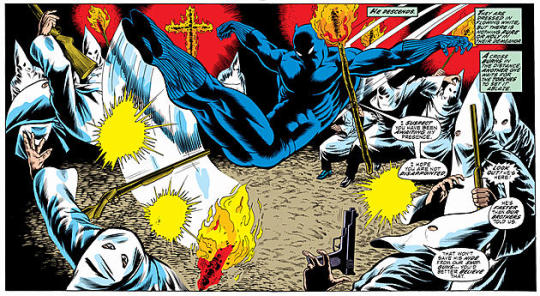
The Black Panther hits theatres this week, and the hysteria and hype surrounding the movie is very, very real.
Starring Chadwick Boseman as the Black Panther and directed by Ryan Coogler (Creed), it's the first film in the Marvel Universe to feature majority Black actors, be helmed by a Black director and be set in a (fictional) African country. Not since Wesley Snipes' Blade has a Black superhero been given such a red-carpet treatment.
In fact, Snipes recently revealed that he tried, unsuccessfully, to get a Black Panther picture off the ground in the '90s.
"I think Black Panther spoke to me because he was noble, and he was the antithesis of the stereotypes presented and portrayed about Africans, African history and the great kingdoms of Africa," he told the Hollywood Reporter. "It had cultural significance, social significance. It was something that the Black community and the white community hadn't seen before."
WhileBlade, released in 1998, ended up being the first hit film based on a Marvel character. Black Panther is on track to be another runaway success, both financially and in its cultural significance. Just take a look at the hashtag #whatdoesblackpanthermeantome, which shows zealous fans remarking on the significance of seeing positive Blackrepresentation on the big screen (everybody owes it to themselves to watch this particularly joyous reaction).
But it was a long road to get here. Below, we trace the key moments in the history of the Black Panther.
The Coal Tiger
Marvel founder Stan Lee and artist Jack Kirby are credited with first coming up with the idea for Black Panther in the mid-'60s, although Kirby's original design and what we see today are drastically different. In fact, even the name was different during the conceptual stage, with Kirby originally calling the hero Coal Tiger.
The Coal Tiger was a regal, albeit old fashioned-looking hero with no mask, complete with a bright yellow jumper and matching boots overtop black tights. Thankfully, this version never made it to print and only exists as a conceptual sketch, seen here.

The original concept for the Black Panther by Jack Kirby. (Marvel)
"I came up with the Black Panther because I realized I had no Blacks in my strip," Kirby said in an interview, highlighting the fact that even during the civil rights era — a time when Black musicians saw unprecedented crossover success — Black representation was still a huge blind spot in comics. "It suddenly dawned on me — believe me, it was for human reasons — I suddenly discovered nobody was doing Blacks. And here I am a leading cartoonist and I wasn't doing a Black."
The Black Panther vs. the Black Panther party
The Black Panther made his official comic book debut in the Fantastic Four, Vol. 1 No. 52 in July 1966, which is the same year the Black Panther party was founded (though some months later). While the comic book and party were not affiliated, they both tapped into the social consciousness of the day, especially in light of recent events such as Malcolm X's assassination and the Watts riots in California. Despite being across the country from each other — Marvel in New York's garment district, the Black Panther founding members in Oakland, Calif. — the comic and the party became intertwined. They both served the need to represent Black Americans, with Marvel choosing to do so by introducing the character of T'Challa, the leader of a fictional country called Wakanda.
"At that point I felt we really needed a Black superhero," Lee told the Huffington Post in 2016. "And I wanted to get away from a common perception. So what I did, I made him almost like [Fantastic Four's] Reed Richards. He's a brilliant scientist and he lives in an area that, under the ground, is very modern and scientific and nobody suspects it because on the surface it's just thatched huts with ordinary 'natives.' And he's not letting the world know what's really going on or how brilliant they really are."
An African utopia
To Lee's point, Wakanda is an African country that was never colonized, due in part to its advanced technology that allowed Wakandans to hide their country from the rest of the world. This idea of an African utopia remained throughout the comic book's history, echoed in the rallying cry "Wakanda forever" from the 2018 film, one that has since been embraced by the film's stars.
From his first appearance, readers were introduced to the Black Panther as both a superhero and the leader of a nation that was technologically superior to the U.S. due to its wealth of vibranium, the fictional metal that is used to construct both Black Panther's suit and Captain America's shield. These are all important factors to the Black Panther's backstory that have remained consistent to this day, even as the Black Panther storylines, over the decades, became more American-focused.
"T'Challa — the Black Panther and mythical ruler of Wakanda — has always struck as the product of the Black nationalist dream, a walking revocation of white supremacist myth," Ta-Nehisi Coates, the Atlantic journalist and author who helmed the 2015 Black Panther comic, wrote at the time.
The first Black superhero
The Black Panther was originally drawn with a cape and open cowl, similar to Batman, which also showed his skin colour. However, Kirby ultimately redesigned his costume, darkening his suit and introducing a full face mask, a look that has remained more or less consistent throughout the character's history. You can see both versions of the cover below.
Even though it was apparent to readers that the character was Black — the Black Panther removes his mask within the pages of his first appearance in Fantastic Four — it wasn't until 1968 that you would see the colour of T'Challa's skin on the cover of a comic book: when the Black Panther appeared in issue No. 52 of The Avengers in a cowl (a partial mask that showed his jaw). This was important because the Black Panther was, in fact, the first Black superhero to appear in a mainstream comic book, predating other mainstream Black heroes, such as the Falcon (1969), Luke Cage (1972) and John Stewart as the Green Lantern (1971). The cowl was short lived, however, and the Black Panther soon returned to his more traditional full-coverage costume.
The Black Leopard
Over time, Marvel got weary about being so closely associated by name with the Black Panther Party, so they changed their superhero's name. It didn't go over well.
Beginning in Fantastic Four No. 119 (February 1972), the Black Panther briefly tried using the name Black Leopard, explaining it with an awkward bit of dialogue within that same issue. While commenting on the name's "political connotations" in the U.S., T'Challa is careful to say, "I neither condemn nor condone those who have taken up the name — but T'Challa is a law unto himself." It's a speech that sounds like it was taken straight from a Marvel press release, written with such hair-splitting caution as to not offend either side while still distancing the character from the political group.
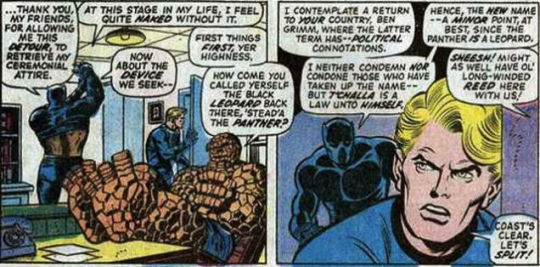
Readers were not fans of the change, and the renaming didn't last long. Neither "the readers nor the creators cared for the new name," Lee told Alter Ego magazine in 2011.
And while Marvel shied away from the politicization of the Black Panther name, many of the superhero's more popular storylines were in fact very political. In the same issue where the Black Leopard name is introduced, T'Challa travels to the fictional country of Rudyarda, a thinly veiled stand in for apartheid-era South Africa. Even the country's name is based on famous British colonial writer Rudyard Kipling, author of, among other things, "the White Man's Burden." In one of the final scenes from this issue, the Thing even smashes through segregated doors before leaving the country in a heavy-handed metaphor for the politics of the day. The Black Panther name may have been too political for Marvel, but the issues of the day certainly weren't.
'Wakandans stop being refugees from a Tarzan movie'
Fast forward one year to 1973, and the Black Panther officially stars in his own run of solo books as part of the uncomfortably named Jungle Action series.
The Black Panther's run in Jungle Action ran from September 1973 to November 1976 and was critically acclaimed, even pioneering a format that's the norm today: a self-contained, multi-issue story, a.k.a. the graphic novel. Called Panther's Rage and penned by Don McGregor, it was conceived as a complete novel told over 13 issues and introduced the antagonist Killmonger, a key character played by Michael B. Jordan in the film.
McGregor was encouraged by Marvel to include more white characters, so in January 1976, he did just that — though perhaps not in the way his editors had in mind — by facing the Black Panther off against the Ku Klux Klan. Captain America may have famously punched Adolph Hitler, but he never drop kicked a member of the Klan in the face quite like the Black Panther (see image at top)
Over 20-odd years, McGregor would introduce other extended Panther storylines (Panther's Prey; Panther's Quest) that helped develop the backstory of Wakanda and T'Challa's character in much more depth. Readers learned more about T'Challa's strength as a leader of an advanced nation, and how he deals with the constant threat from both imperialist and interior forces.
"These stories are where Wakandans stop being refugees from a Tarzan movie," writer Evan Narcisse so aptly points out.
The Black Panther becomes cool, with some help from Chandler Bing
Following an unsuccessful solo run penned by Kirby, sales and interest in the Black Panther character waned during the '80s. Storylines became more cliché, adding very little to make the character stand out from other Marvel superheroes. Then, in the '90s, Christopher Priest took up the mantle and reinvigorated the character completely.
"[Priest] had the classic run on Black Panther, period, and that's gonna be true for a long time," Coates told New York magazine for a profile on Priest titled, "The Man who Made Black Panther Cool."
As such, Priest's run also introduced some fairly major changes to T'Challa's costume, with gold accents around his neck, wrists and waist, plus the return of his cape, giving the character his most regal look yet. Priest, more than anyone before him, focused on T'Challa as a king, so the superhero was going to look the part.
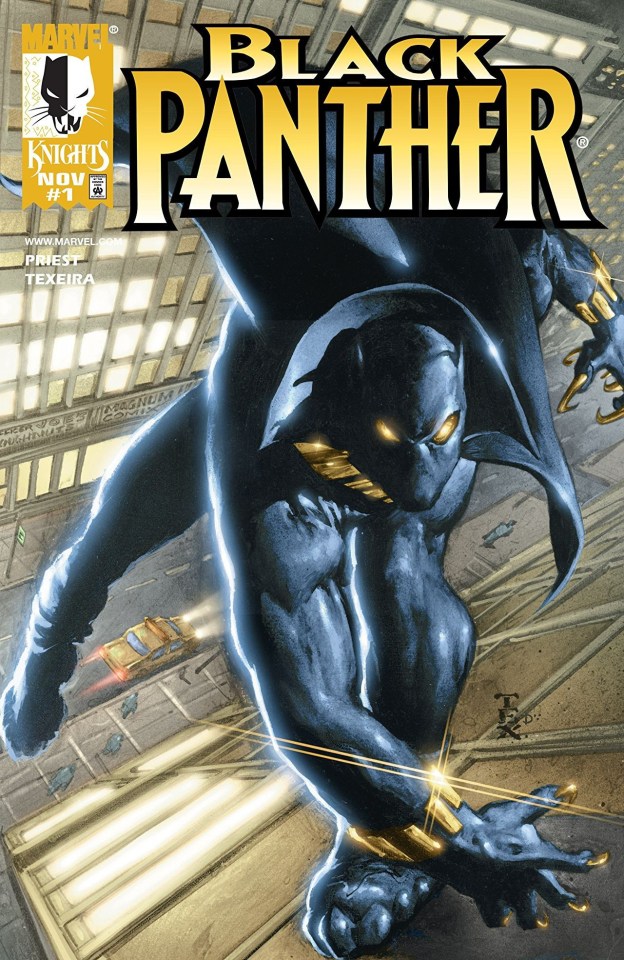
It's important to note that Priest was the first Black editor/writer to be hired by either of the big two comic brands, Marvel and DC. After some ups and downs, including leaving Marvel for DC, Priest was offered Black Panther in 1998. This was the beginning of a trend that saw many prominent Black artists take the lead on the Black Panther.
"I was a little horrified when the words 'Black' and 'Panther' came out of Joe's mouth," Priest later wrote. "I mean, Black Panther? Who reads Black Panther?"
Needless to say, Black Panther's history did not inspire Priest — "His supporting cast was a bunch of soul brothers in diapers with bones through their noses," Priest wrote — but he was eventually convinced to take the job, provided one detail: he wanted to create a white protagonist. In Priest's own words: "go to the wells of snarkdom, for the snarkiest snark I was capable of. Social politics as interpreted by Richard Belzer, Dennis Leary or Dennis Miller."
Inspired by an episode of Friends (yes, that Friends), Priest created a character based on Chandler Bing. Everett K. Ross was a paranoid, incompetent government employee tasked as a diplomatic escort for T'Challa, who was portrayed as a superlative statesman by day and merciless vigilante by night. The Black Panther series morphed into a mix of political thriller, satire and traditional superhero story, told through the sarcastic point of view of Ross, with an emphasis on T'Challa's cunning wit, strength and sense of justice.
"This was how the book achieved its small cult following," Priest writes.
To Priest, T'Challa wasn't simply a superhero, and the Black Panther was more than just a superhero title.
"People had not put as much thought into who and what Black Panther was before Christopher started writing the book," Coates says in that same New York magazine interview. "He thought that Black Panther was a king."
The formula worked, and Priest's run lasted for 62 issues, becoming the defining interpretation of the character.
Introducing women warriors
In line with his expansion of the Wakandan universe, Priest also introduced another major cast of characters to the Black Panther universe — the Dora Milaje, T'Challa's fierce and all-female personal bodyguards. They are some of the deadliest women in the Marvel universe, but in Priest's initial run, they were also depicted as ceremonial "wives in training," an idea that has not aged well.
Based on Tyra Banks and Naomi Campbell, the Dora Milaje were, at least in the early days, often depicted as femme fatales in short skirts and high heels. Thankfully the movie jettisons that aspect of the Dora Milaje background, focusing instead on the women's efficiency as warriors and, even more so, as key characters to the development of the story.

"I think the presentation of women is both fierce and very much feminine," Danai Gurira, who plays the head of the Dora Milaje, Okoye, in the film, tellsq. "I loved the way the women were shown being people that reach their fullest potential and live in it with a fearlessness and don't lose any part of being women. The myth is that's what happens, or women have to disguise their strength and I love that this is a world where that is just not the case."
In the 2000s, Reginald Hudlin, a writer, director and producer (his breakout film was 1990's House Party with rappers Kid 'n Play), focused on Black Panther's "street cred," drawing inspiration from Batman, Spike Lee and P Diddy. One key development from Hudlin was the creation of Shuri, T'Challa's younger sister and a tech genius who is played by Letitia Wright in the film. In the comics, she even replaces T'Challa for a time as the Black Panther and ruler of Wakanda.
This era emphasized, above all, the power and agency of the women in the Panther universe, a theme expanded on even more in the books to follow and film. Hudlin's run was also used as the basis for an excellent animated series, which ran on BET.
The extended Black Panther universe
When Coates picked up the mantle in 2016, he expanded on what Priest and Hudlin had built, but also subverted readers' expectations of the character to that point. In an interview, Coates describes fans needing T'Challa to be like Denzel Washington— "He's supposed to be smooth and effortlessly do x, y, and z." — but for Coates, it was also important to show T'Challa as flawed. "You got Denzel ... [but in] that movie where he's a drunken pilot."
Coates also focused the action back on Wakanda, questioning the very systems that held the otherwise utopian country together. Under Coates, women were made more and more crucial to the overall story, focusing more on their actual lives rather than how their characters relate to T'Challa.
Coates even ventured to develop the Panther universe in more depth with a spin-off, World of Wakanda, written with Roxane Gay (author of Bad Feminist, Hunger) and Yona Harvey, the first two Black women to write a series for Marvel. One storyline focused on the romance between Ayo and Anneka, two women who are also the driving forces to a Dora Milaje-led resistance that results in a civil war.
World of Wakanda, however, was cancelled after six issues. Even with a best-selling author and National Book Award winner, perhaps even that was too much for the traditional comic book-buying public. The series was cancelled due to poor sales, with Marvel Studios' vice president even commenting at one point that "people didn't want any more diversity."
Although with 2018's Black Panther already breaking box-office records, this theory has been proven wrong. For a character that was, at its core, created in order to the reflect the times and to combat discrimination, it's a fitting next chapter for the Black Panther.
1 note
·
View note
Text
Tongue in Chic: Tiffany’s $1,000 Tin Can to Moschino’s $735 Plastic Bag
Tiffany & Co.—#81 on Interbrand’s Best Global Brands list of the world’s most valuable brands—has been considered a bastion of luxury goods for 180 years, purveyor of all things elegant in jewelry, sterling silver, china, crystal, stationery, fragrances, water bottles, watches, personal accessories and leather goods. Some may wonder if it’s tired of being an arbiter of taste and style with its latest collection.
Its exorbitantly-priced new home goods collection by creative director Reed Krakoff, Everyday Objects, elevates those objects to ridiculous heights and price: a $1,000 sterling silver tin can, a $9,000 sterling silver ball of yarn (one of only five made), a $425 walnut and silver protractor for the math whiz in the family (complete the set with the matching $400 triangle and $450 ruler), a $385 harmonica, a $1,500 set of 10 LEGO-like walnut and silver building blocks, $650 table tennis paddles, a $950 “paper plate” and $95 pair of bone china “paper cups” and a $300 yo-yo for all ages. At least there’s free shipping and returns on each order.
Tiffany said the collection “transforms utilitarian items into handcrafted works of art.” Krakoff, Tiffany’s chief artistic officer, added to the Guardian that “What makes the collection unique is that it incorporates the best quality, craftsmanship and design with a level of functionality that allows you to use these things every day.”
Introducing The Silver Cup Project, featuring our sterling silver coffee cup from the new Home & Accessories collection. #TiffanyEveryDay
A post shared by Tiffany & Co. (@tiffanyandco) on Nov 1, 2017 at 8:37am PDT
//platform.instagram.com/en_US/embeds.js
Released in time for the holiday shopping season and year-end gift-giving, one rationalization is Everyday Objects is a PR stunt to draw attention away from declining sales, its version of the famed Neiman Marcus Christmas Book which has included pricey, elaborate items as much to fantasize about as to purchase.
No hands. Introducing our new Home & Accessories collection. #TiffanyEveryDay Shop the link in our bio. Artwork: Christoph Niemann @abstractsunday #TiffanyEveryDay
A post shared by Tiffany & Co. (@tiffanyandco) on Oct 31, 2017 at 3:08pm PDT
//platform.instagram.com/en_US/embeds.js
Tiffany’s Everyday Object collection (brought to life by artist Christoph Niemann on its Instagram and Twitter feeds) is explained on its website as, “Beautiful things shouldn’t just live in a drawer. Handcrafted in sterling silver, enamel and wood, this new collection elevates traditional office supplies and accessories into works of art meant to become favorite pieces you use every day.”
$TIF has $250 Crazy Straws as part of their “Everyday objects” collection. (Ht @Banker_L83 ) https://t.co/9rdta9TAHL pic.twitter.com/5b0u4WJRkZ
— Jeff Macke (@JeffMacke) November 8, 2017
https://platform.twitter.com/widgets.js
Derek Conrad, a company spokesman, told TODAY, “While there are certainly extraordinary items at elevated price points, the vast majority of products in the collection are actually under $500.” (Bargain!)
Keep paddling. Introducing our new Home & Accessories collection. #TiffanyEveryDay Shop the link in our bio. Artwork: Christoph Niemann @abstractsunday
A post shared by Tiffany & Co. (@tiffanyandco) on Oct 31, 2017 at 11:24am PDT
//platform.instagram.com/en_US/embeds.js
Krakoff, who joined Tiffany in January, told The New York Times, “The main thing we were trying to bring back was that aesthetic of the extraordinary as well as the everyday. We’re just getting started.”
Something blue. Introducing our new Home & Accessories collection. #TiffanyEveryDay Shop the link in our bio. : @roeethridge
A post shared by Tiffany & Co. (@tiffanyandco) on Oct 26, 2017 at 3:03pm PDT
//platform.instagram.com/en_US/embeds.js
Tiffany & Co. has been getting hipper of late, and a little more Burberry-esque with the musicians (such as Annie Clark, aka Saint Vincent) and other hipsters featured in its recent “Iconoclasts” campaign.
youtube
Its Manhattan flagship has been remodeled to make space for the new home collection, with the New York flagship store divided into semi-enclosed sections, each with unique furnishings and décor and ampersands to suggest this is a sidecar to the Tiffany & Co. brand, as the New York Times noted this week.
Can you hear that sound? Introducing our new Home & Accessories collection. #TiffanyEveryDay Artwork: Christoph Niemann @abstractsunday
A post shared by Tiffany & Co. (@tiffanyandco) on Oct 25, 2017 at 3:00pm PDT
//platform.instagram.com/en_US/embeds.js
“The first thing the team and I wanted to accomplish was to create a space that could’ve been part of Tiffany history,” Krakoff told the Times. “To take this neoclassical interior, bright and light and simple, and juxtapose that with surprise, modernity and the unexpected. One of the fundamental goals of this floor is to bring the magic and extraordinary creativity of the Tiffany window into the store itself. Think of the windows of Gene Moore in the ’60s that juxtaposed a toy steam shovel with a pile of sand and an extraordinary diamond in a Tiffany setting. I wanted to be sure to capture that spirit, of an offhanded luxury.”
Start the day with a touch of Tiffany Blue®. #TiffanyEveryDay pic.twitter.com/gM0iLScCFI
— Tiffany & Co. (@TiffanyAndCo) October 26, 2017
https://platform.twitter.com/widgets.js
Tiffany’s signature ro
from WordPress https://glenmenlow.wordpress.com/2017/11/08/tongue-in-chic-tiffanys-1000-tin-can-to-moschinos-735-plastic-bag/ via IFTTT
0 notes
Text
modern AU jobs for the gang
what jobs/positions/etc would they have if the rulers and monarchs were never a thing? well...
(this list is a little long, just a heads up)
Choi Jong-In: arsonist Forensic scientist
Baek Yoon-Ho: I know in canon they mention him being a firefighter? which i kinda see, since he seems like the type to want to help people. but, besides that, I could also see him as a EMT or something along those lines
Min Byung-Gyu: He would 100% be a nurse. He gives me tired and slightly unhinged med student vibes
Cha Hae-In: Personal trainer perhaps? Or a martial arts teacher?
Lim Tae-Gyu: Competitive archer (probably won a few silvers and a gold at the olympics and afterwards he immediately retired)
Woo Jin-Chul: Accountant. or! or a math teacher! but i imagine he'd be too tired to deal with kids, so
Go Gun-Hee: The korean equivalent of a DA. i was gonna say judge but that doesn't seem up his alley, so
Yoo Jin-Ho: I mean... he's rich... that aside, he'd probably start a company with his money, probably for bioengineering research stuff. anything to help people, yeah?
Sung Jin-Woo: Well, he'd still be how he was at chapter 1, so... hm... maybe a librarian or something like that? i'd imagine he likes books a lot
Thomas Andre: Can you imagine this man in the real estate market... selling houses... "oh you're the construction worker?" "nah im sellin this house!" and the buyer would like. visibly pale. because this man would still be built like a brickhouse i can guarantee it
Laura: Architect/interior designer (she probably flips houses with Thomas and he splits the profits with her)
Christopher Reed: Marine biologist + animal/environment activist
Lennart Niermann: Hair stylist
Liu Zhigang: Blacksmith. he'd be so good at creating swords
Goto Ryuiji: Grumpy but diligent manager at an office
Reiji Sugimoto: Aspiring musician/singer
Akari Shimizu: Either an entomologist or a pediatrician, though i feel like the latter is too obvious since she's a healer
Kenzo Tanaka: PE teacher + school counselor
Atsushi Kumamoto: Probably part of a cleaning service
Ippei Izawa: Twitch streamer. he just. gives me those vibes. gaemer
Kei: Psychologist + profiler
Kanae Tawata: Tattoo artist
Minoru Hoshino: Works at the same office as Goto. one of the few to put up with his grumpiness
Mari Ishida: Lawyer. she'd either be loved or hated since she's a stickler for rules and procedures
Tatsumi Fujishima: He'd work as an engineer for NASA perhaps, or maybe try and start his own robotics company. You know those robot dogs? yeah. yup. he'd love that
#Choi Jong-In#Baek Yoon-Ho#Min Byung-Gyu#Cha Hae-In#Lim Tae-Gyu#Woo Jin-Chul#Go Gun-Hee#Yoo Jin-Ho#Sung Jin-Woo#Thomas Andre#Laura#Solo Leveling#only i level up#Christopher Reed#Lennart Niermann#Liu Zhigang#Goto Ryuji#Reiji Sugimoto#Akari Shimizu#Kenzo Tanaka#Atsushi Kumamoto#Ippei Izawa#Kei#Kanae Tawata#Minoru Hoshino#Mari Ishida#Tatsumi Fujishima#head canons
75 notes
·
View notes
Text
Tongue in Chic: Tiffany’s $1,000 Tin Can to Moschino’s $735 Plastic Bag
Tiffany & Co.—#81 on Interbrand’s Best Global Brands list of the world’s most valuable brands—has been considered a bastion of luxury goods for 180 years, purveyor of all things elegant in jewelry, sterling silver, china, crystal, stationery, fragrances, water bottles, watches, personal accessories and leather goods. Some may wonder if it’s tired of being an arbiter of taste and style with its latest collection.
Its exorbitantly-priced new home goods collection by creative director Reed Krakoff, Everyday Objects, elevates those objects to ridiculous heights and price: a $1,000 sterling silver tin can, a $9,000 sterling silver ball of yarn (one of only five made), a $425 walnut and silver protractor for the math whiz in the family (complete the set with the matching $400 triangle and $450 ruler), a $385 harmonica, a $1,500 set of 10 LEGO-like walnut and silver building blocks, $650 table tennis paddles, a $950 “paper plate” and $95 pair of bone china “paper cups” and a $300 yo-yo for all ages. At least there’s free shipping and returns on each order.
Tiffany said the collection “transforms utilitarian items into handcrafted works of art.” Krakoff, Tiffany’s chief artistic officer, added to the Guardian that “What makes the collection unique is that it incorporates the best quality, craftsmanship and design with a level of functionality that allows you to use these things every day.”
Introducing The Silver Cup Project, featuring our sterling silver coffee cup from the new Home & Accessories collection. #TiffanyEveryDay
A post shared by Tiffany & Co. (@tiffanyandco) on Nov 1, 2017 at 8:37am PDT
Released in time for the holiday shopping season and year-end gift-giving, one rationalization is Everyday Objects is a PR stunt to draw attention away from declining sales, its version of the famed Neiman Marcus Christmas Book which has included pricey, elaborate items as much to fantasize about as to purchase.
No hands. Introducing our new Home & Accessories collection. #TiffanyEveryDay Shop the link in our bio. Artwork: Christoph Niemann @abstractsunday #TiffanyEveryDay
A post shared by Tiffany & Co. (@tiffanyandco) on Oct 31, 2017 at 3:08pm PDT
Tiffany’s Everyday Object collection (brought to life by artist Christoph Niemann on its Instagram and Twitter feeds) is explained on its website as, “Beautiful things shouldn’t just live in a drawer. Handcrafted in sterling silver, enamel and wood, this new collection elevates traditional office supplies and accessories into works of art meant to become favorite pieces you use every day.”
$TIF has $250 Crazy Straws as part of their “Everyday objects” collection. (Ht @Banker_L83 ) https://t.co/9rdta9TAHL pic.twitter.com/5b0u4WJRkZ
— Jeff Macke (@JeffMacke) November 8, 2017
Derek Conrad, a company spokesman, told TODAY, “While there are certainly extraordinary items at elevated price points, the vast majority of products in the collection are actually under $500.” (Bargain!)
Keep paddling. Introducing our new Home & Accessories collection. #TiffanyEveryDay Shop the link in our bio. Artwork: Christoph Niemann @abstractsunday
A post shared by Tiffany & Co. (@tiffanyandco) on Oct 31, 2017 at 11:24am PDT
Krakoff, who joined Tiffany in January, told The New York Times, “The main thing we were trying to bring back was that aesthetic of the extraordinary as well as the everyday. We’re just getting started.”
Something blue. Introducing our new Home & Accessories collection. #TiffanyEveryDay Shop the link in our bio. : @roeethridge
A post shared by Tiffany & Co. (@tiffanyandco) on Oct 26, 2017 at 3:03pm PDT
Tiffany & Co. has been getting hipper of late, and a little more Burberry-esque with the musicians (such as Annie Clark, aka Saint Vincent) and other hipsters featured in its recent “Iconoclasts” campaign.
youtube
Its Manhattan flagship has been remodeled to make space for the new home collection, with the New York flagship store divided into semi-enclosed sections, each with unique furnishings and décor and ampersands to suggest this is a sidecar to the Tiffany & Co. brand, as the New York Times noted this week.
Can you hear that sound? Introducing our new Home & Accessories collection. #TiffanyEveryDay Artwork: Christoph Niemann @abstractsunday
A post shared by Tiffany & Co. (@tiffanyandco) on Oct 25, 2017 at 3:00pm PDT
“The first thing the team and I wanted to accomplish was to create a space that could’ve been part of Tiffany history,” Krakoff told the Times. “To take this neoclassical interior, bright and light and simple, and juxtapose that with surprise, modernity and the unexpected. One of the fundamental goals of this floor is to bring the magic and extraordinary creativity of the Tiffany window into the store itself. Think of the windows of Gene Moore in the ’60s that juxtaposed a toy steam shovel with a pile of sand and an extraordinary diamond in a Tiffany setting. I wanted to be sure to capture that spirit, of an offhanded luxury.”
Start the day with a touch of Tiffany Blue®. #TiffanyEveryDay pic.twitter.com/gM0iLScCFI
— Tiffany & Co. (@TiffanyAndCo) October 26, 2017
Tiffany’s signature ro
0 notes
Text
Tongue in Chic: Tiffany’s $1,000 Tin Can to Moschino’s $735 Plastic Bag
Tiffany & Co.—#81 on Interbrand’s Best Global Brands list of the world’s most valuable brands—has been considered a bastion of luxury goods for 180 years, purveyor of all things elegant in jewelry, sterling silver, china, crystal, stationery, fragrances, water bottles, watches, personal accessories and leather goods. Some may wonder if it’s tired of being an arbiter of taste and style with its latest collection.
Its exorbitantly-priced new home goods collection by creative director Reed Krakoff, Everyday Objects, elevates those objects to ridiculous heights and price: a $1,000 sterling silver tin can, a $9,000 sterling silver ball of yarn (one of only five made), a $425 walnut and silver protractor for the math whiz in the family (complete the set with the matching $400 triangle and $450 ruler), a $385 harmonica, a $1,500 set of 10 LEGO-like walnut and silver building blocks, $650 table tennis paddles, a $950 “paper plate” and $95 pair of bone china “paper cups” and a $300 yo-yo for all ages. At least there’s free shipping and returns on each order.
Tiffany said the collection “transforms utilitarian items into handcrafted works of art.” Krakoff, Tiffany’s chief artistic officer, added to the Guardian that “What makes the collection unique is that it incorporates the best quality, craftsmanship and design with a level of functionality that allows you to use these things every day.”
Introducing The Silver Cup Project, featuring our sterling silver coffee cup from the new Home & Accessories collection. #TiffanyEveryDay
A post shared by Tiffany & Co. (@tiffanyandco) on Nov 1, 2017 at 8:37am PDT
Released in time for the holiday shopping season and year-end gift-giving, one rationalization is Everyday Objects is a PR stunt to draw attention away from declining sales, its version of the famed Neiman Marcus Christmas Book which has included pricey, elaborate items as much to fantasize about as to purchase.
No hands. Introducing our new Home & Accessories collection. #TiffanyEveryDay Shop the link in our bio. Artwork: Christoph Niemann @abstractsunday #TiffanyEveryDay
A post shared by Tiffany & Co. (@tiffanyandco) on Oct 31, 2017 at 3:08pm PDT
Tiffany’s Everyday Object collection (brought to life by artist Christoph Niemann on its Instagram and Twitter feeds) is explained on its website as, “Beautiful things shouldn’t just live in a drawer. Handcrafted in sterling silver, enamel and wood, this new collection elevates traditional office supplies and accessories into works of art meant to become favorite pieces you use every day.”
$TIF has $250 Crazy Straws as part of their “Everyday objects” collection. (Ht @Banker_L83 ) https://t.co/9rdta9TAHL http://pic.twitter.com/5b0u4WJRkZ
— Jeff Macke (@JeffMacke) November 8, 2017
Derek Conrad, a company spokesman, told TODAY, “While there are certainly extraordinary items at elevated price points, the vast majority of products in the collection are actually under $500.” (Bargain!)
Keep paddling. Introducing our new Home & Accessories collection. #TiffanyEveryDay Shop the link in our bio. Artwork: Christoph Niemann @abstractsunday
A post shared by Tiffany & Co. (@tiffanyandco) on Oct 31, 2017 at 11:24am PDT
Krakoff, who joined Tiffany in January, told The New York Times, “The main thing we were trying to bring back was that aesthetic of the extraordinary as well as the everyday. We’re just getting started.”
Something blue. Introducing our new Home & Accessories collection. #TiffanyEveryDay Shop the link in our bio. : @roeethridge
A post shared by Tiffany & Co. (@tiffanyandco) on Oct 26, 2017 at 3:03pm PDT
Tiffany & Co. has been getting hipper of late, and a little more Burberry-esque with the musicians (such as Annie Clark, aka Saint Vincent) and other hipsters featured in its recent “Iconoclasts” campaign.
youtube
Its Manhattan flagship has been remodeled to make space for the new home collection, with the New York flagship store divided into semi-enclosed sections, each with unique furnishings and décor and ampersands to suggest this is a sidecar to the Tiffany & Co. brand, as the New York Times noted this week.
Can you hear that sound? Introducing our new Home & Accessories collection. #TiffanyEveryDay Artwork: Christoph Niemann @abstractsunday
A post shared by Tiffany & Co. (@tiffanyandco) on Oct 25, 2017 at 3:00pm PDT
“The first thing the team and I wanted to accomplish was to create a space that could’ve been part of Tiffany history,” Krakoff told the Times. “To take this neoclassical interior, bright and light and simple, and juxtapose that with surprise, modernity and the unexpected. One of the fundamental goals of this floor is to bring the magic and extraordinary creativity of the Tiffany window into the store itself. Think of the windows of Gene Moore in the ’60s that juxtaposed a toy steam shovel with a pile of sand and an extraordinary diamond in a Tiffany setting. I wanted to be sure to capture that spirit, of an offhanded luxury.”
Start the day with a touch of Tiffany Blue®. #TiffanyEveryDay http://pic.twitter.com/gM0iLScCFI
— Tiffany & Co. (@TiffanyAndCo) October 26, 2017
Tiffany’s signature ro
0 notes
Text
Tiffany & Co releases £945 tin can as part of Everyday Objects collection
New York jewellers Tiffany & Co has created a line of everyday items re-imagined in expensive materials, including a gold and silver tin can and a ball of yarn recreated in handspun silver for £6,840.
The shapes of common or oft-discarded objects have been cast in precious metals, expensive wood and fine porcelain for the Everyday Objects collection.
Tiffany & Co "upgraded" a 11.5-centimetre-tall can, giving it a sterling silver exterior, gold vermeil interior and an enamel stripe in trademark Tiffany Blue.
The jewellers decided to elevate these utilitarian objects to luxury status because "beautiful things should not be limited to special occasions".
"I think what makes the collection unique is that it incorporates the best quality, craftsmanship and design with a level of functionality that allows you to use these things every day," Reed Krakoff, chief artistic officer at Tiffany & Co said in a statement.
All of the items are fully functional and campaign shots show them being used to serve drinks, hold pencils, and scattered casually over desks and tables.
A set of two paper cups, inspired by the disposable vessels used to serve coffee in the Tiffany & Co shops, are available in sterling silver for £540.
A less pricey version in dishwasher-safe bone china realised in Tiffany & Co's signature teal can be purchased for £90. They could be paired with a sterling silver "paper plate" for £722.
A set of 10 stackable building bricks made from silver and walnut are priced at £1,140 and marketed as a "playful desk accessory".
Also for the desk, there is a silver, walnut and enamel-accented ruler (£425), protractor (£400), and triangle (£375).
The most expensive item in the collection is the £6,840 "ball of yarn", made from hand-spun strands of sterling silver.
A pair of table tennis bats crafted from reclaimed American walnut and black and blue leather can be acquired for £650, and a Tiffany & Co-branded ping-pong ball is also included in the set.
The "crazy straw" is a spiral drinking straw with a blue enamel band available in silver for £235, or a £330 version in either gold or rose gold.
The luxury design house said the designs are all "tongue-in-cheek" and pay homage to Gene Moore, the designer and window dresser who displayed Tiffany & Co jewels in paint cans with splashes of neon paint.
The paint can is referenced in the centimetre-tall lead crystal ice bucket with a sterling silver handle for £912. Engraving is available on most of the items.
Reimagining common or garden objects in opulent materials is a favourite trope of designers.
London designer Christopher Jenner recently collaborated with British heritage brand Elkington and Co to create a 24-piece set of everyday items such as tea pots and salad servers in luxury materials including silver and hand blown crystal.
Related story
Christopher Jenner updates traditional silverware with contemporary shapes
The post Tiffany & Co releases £945 tin can as part of Everyday Objects collection appeared first on Dezeen.
from ifttt-furniture https://www.dezeen.com/2017/11/08/tiffany-co-jewellers-new-york-everyday-objects-tin-can-gold-silver-luxury/
0 notes